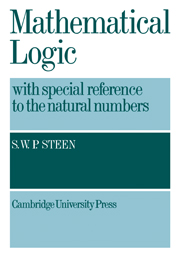Book contents
- Frontmatter
- Contents
- Preface
- Introduction
- Chapter 1 Formal systems
- Chapter 2 Propositional calculi
- Chapter 3 Predicate calculi
- Chapter 4 A complete, decidable arithmetic. The system Aoo
- Chapter 5 Aoo-Definable functions
- Chapter 6 A complete, undecidable arithmetic. The system Ao
- Chapter 7 Ao-Definable functions. Recursive function theory
- Chapter 8 An incomplete undecidable arithmetic. The system A
- Chapter 9 A-Definable sets of lattice points
- Chapter 10 Induction
- Chapter 11 Extensions of the system AI
- Chapter 12 Models
- Epilogue
- Glossary of special symbols
- Note on references
- References
- Index
Chapter 12 - Models
Published online by Cambridge University Press: 07 October 2011
- Frontmatter
- Contents
- Preface
- Introduction
- Chapter 1 Formal systems
- Chapter 2 Propositional calculi
- Chapter 3 Predicate calculi
- Chapter 4 A complete, decidable arithmetic. The system Aoo
- Chapter 5 Aoo-Definable functions
- Chapter 6 A complete, undecidable arithmetic. The system Ao
- Chapter 7 Ao-Definable functions. Recursive function theory
- Chapter 8 An incomplete undecidable arithmetic. The system A
- Chapter 9 A-Definable sets of lattice points
- Chapter 10 Induction
- Chapter 11 Extensions of the system AI
- Chapter 12 Models
- Epilogue
- Glossary of special symbols
- Note on references
- References
- Index
Summary
Models and truth-definitions
Models of formal systems are intimately connected with truthdefinitions. They are mainly constructed when the system has variables and statements. A system with statements but without variables can usually act as its own model, so the construction of models for such a system is unnecessary. A truth-definition is connected with statements, so only applies to systems with statements, and can be attempted whether the system has variables or otherwise. In previous chapters we have stated exactly what we require of a truth-definition, now we must do the same for a model. We have omitted to discuss whether a given formal system has two or more distinct truth-definitions, but we shall, in this chapter, discuss whether a formal system can have more than one model, and from each model we can get a truth-definition. The truth-definitions we have given so far for various systems of arithmetic are what we shall call standard truth-definitions.
Our aim in constructing formal systems of arithmetic was to invent a language in which we could express thoughts about natural numbers and give some method of procedure whereby we could obtain those statements about natural numbers which are true in the standard truth-definition. Some statements about natural numbers are intuitively obvious (their formal proof in any formal system would be very easy) and we scarcely need to form a formal system if we are only going to use such statements, e.g. that part of arithmetic used in banking, cooking, etc.
Information
- Type
- Chapter
- Information
- Mathematical Logic with Special Reference to the Natural Numbers , pp. 563 - 608Publisher: Cambridge University PressPrint publication year: 1972
